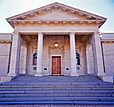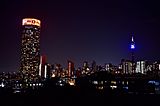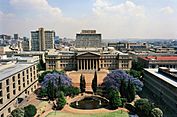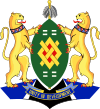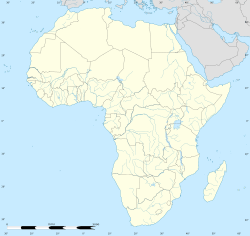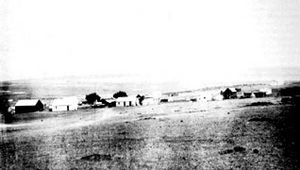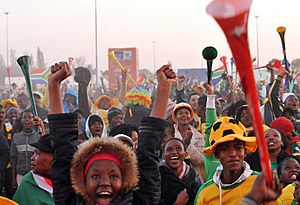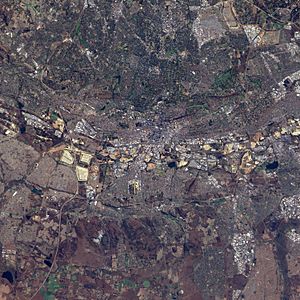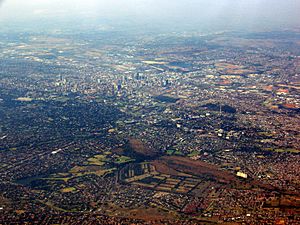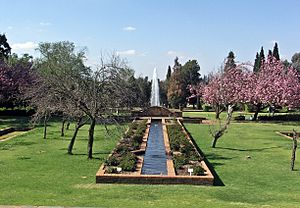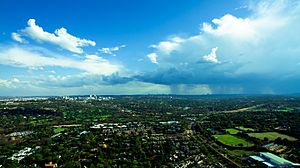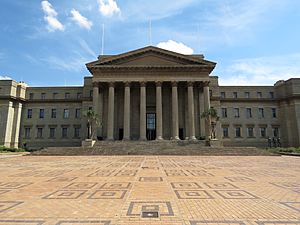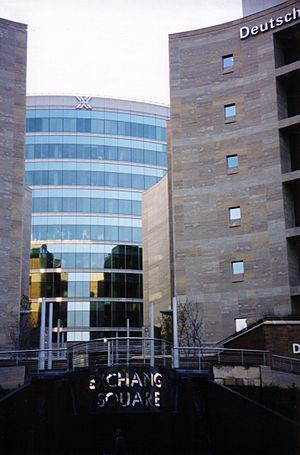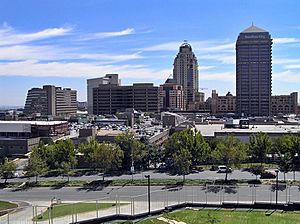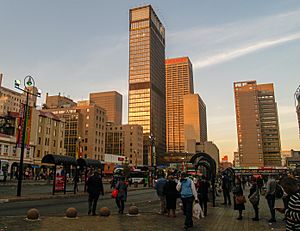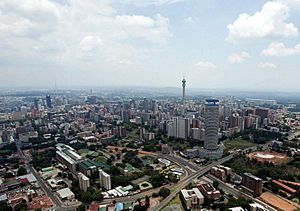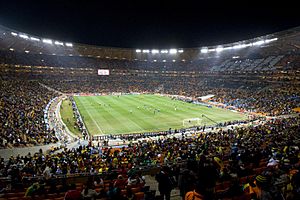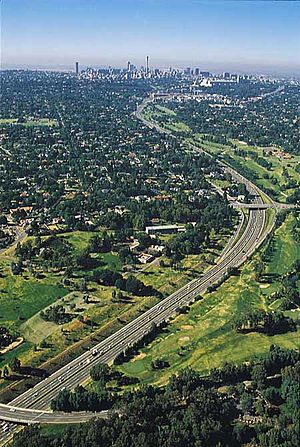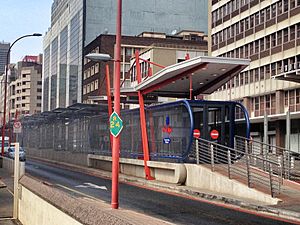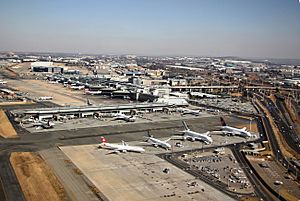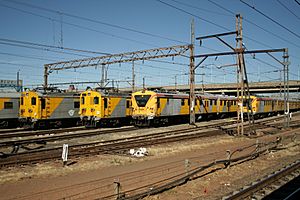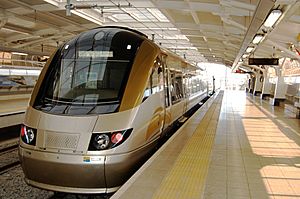Johannesburg facts for kids
Quick facts for kids
Johannesburg
|
|||
|---|---|---|---|
| City of Johannesburg | |||
|
Johannesburg CBD
Johannesburg Art Gallery
Hillbrow Tower and Ponte City
Brixton Tower
|
|||
|
|||
| Nickname(s): | |||
| Motto(s):
"Service with Pride"
|
|||
|
OpenStreetMap
|
|||
| Country | South Africa | ||
| Province | Gauteng | ||
| Municipality | City of Johannesburg | ||
| Established | 1886 | ||
| Government | |||
| • Type | Metropolitan municipality | ||
| Area | |||
| • Megacity | 1,644.98 km2 (635.13 sq mi) | ||
| • Urban | 3,357 km2 (1,296 sq mi) | ||
| Elevation | 1,753 m (5,751 ft) | ||
| Population
(2022)
|
|||
| • Megacity | 4,803,262 | ||
| • Density | 2,919.952/km2 (7,562.640/sq mi) | ||
| • Urban | 8,500,000 | ||
| • Urban density | 2,532/km2 (6,560/sq mi) | ||
| • Metro | 11,000,000 | ||
| Racial makeup (2019) | |||
| • Black African | 76.4% | ||
| • White | 12.3% | ||
| • Coloured | 5.6% | ||
| • Indian/Asian | 4.9% | ||
| • Other | 0.8% | ||
| First languages (2011) | |||
| • Zulu | 23.41% | ||
| • English | 20.10% | ||
| • Sesotho | 9.61% | ||
| • Setswana | 7.68% | ||
| • Afrikaans | 7.28% | ||
| • Other | 18.10% | ||
| Time zone | UTC+2 (SAST) | ||
| Postal code (street) |
2001
|
||
| PO box |
2000
|
||
| Area code | 010 and 011 | ||
| HDI | |||
| GDP | US$131 billion (2020) | ||
| GDP per capita (PPP) | US$16 370 (2014) | ||
Johannesburg (pronounced joh-HAN-iss-burg), often called Jozi or Joburg, is the biggest city in South Africa. It's home to over 4.8 million people, making it one of the largest cities in the world. Johannesburg is the capital of Gauteng province, which is the richest province in South Africa.
The city is also known as "The City of Gold" because it was founded in 1886 after a huge discovery of gold. This discovery made the city grow incredibly fast. Johannesburg is where South Africa's highest court, the Constitutional Court, is located. Many major South African companies and banks also have their main offices here.
For many years, areas like Soweto and Lenasia were kept separate from other parts of Johannesburg. This was due to past laws that divided people based on their race. Today, these areas are part of the larger Johannesburg metropolitan area. The city was also a host for the 2010 FIFA World Cup, even holding the final match!
Contents
What's in a Name?
The exact reason for Johannesburg's name is a bit of a mystery! Many people named "Johannes" were important in the city's early days.
- Christiaan Johannes Joubert was a mining chief.
- Paul Kruger was the president of the South African Republic.
- Johannes Meyer was the first government official in the area.
Records about how the name was chosen were lost. However, Johannes Rissik and Christian Johannes Joubert were part of a group that helped get mining rights for the area. You can find a park named after Joubert and a main street named after Rissik in the city today.
A Glimpse into History
The area around Johannesburg was first home to San hunter-gatherers thousands of years ago. Later, Sotho–Tswana communities built stone-walled towns and villages here.
However, many of these towns were destroyed in wars during the late 1700s and early 1800s. After these wars, the Ndebele group, who were related to the Zulu kingdom, set up their own kingdom nearby.
The Gold Rush and City's Birth
In 1884, gold was found on a farm called Vogelstruisfontein by Jan Gerritse Bantjes. This discovery started the famous Witwatersrand Gold Rush. People rushed to the area, and Johannesburg was officially founded in 1886.
Because of the huge amount of gold, the city grew incredibly fast. Within just ten years, Johannesburg had a population of over 100,000 people! The first miners' camp was set up near a place called Fordsburg, where water was available. This camp quickly grew into a town.
Mines near Johannesburg are some of the deepest in the world, going down as far as 4,000 meters (about 2.5 miles).
Growing Pains and Big Changes
In the late 1800s, Johannesburg was a busy but unorganized place. People from all over the world came to work in the mines. There were white miners, African workers, traders, and many others.
Tensions grew between the local government and the British, leading to the Second Boer War (1899–1902). British forces took control of the city in 1900. During the war, many mine workers left, so laborers from China were brought in. After the war, black workers returned, but many Chinese people stayed and formed a community.
After 1910, Johannesburg continued to grow. Large buildings were constructed in the 1930s. In the 1950s and 1960s, the government built huge areas called townships, like Soweto, for black families. These areas were kept separate from white areas due to a system called apartheid.
Even though people worked together in Johannesburg, they were forced to live separately. This was to keep Johannesburg as South Africa's economic center.
A New Century for Johannesburg
In the 1980s and 1990s, some parts of the city center faced challenges, including a rise in crime. Many businesses and residents moved to the suburbs. However, in the 21st century, there's a big effort to make the inner city vibrant again.
One example is the Maboneng District, which has become a lively area with art, restaurants, and shops. Johannesburg also hosted the 15th BRICS summit in August 2023. Sadly, in August 2023, a building fire caused many deaths, highlighting issues with unsafe buildings.
City's Layout and Nature
What the Land Looks Like
Johannesburg sits on a high plateau in South Africa called the Highveld, about 1,753 meters (5,751 feet) above sea level. The city center is on the southern side of a ridge called the Witwatersrand, which means "White Water's Ridge."
This ridge divides the water flow: the northern part of the city drains into the Limpopo River, and the southern part drains into the Vaal River. Even though Johannesburg isn't on a big river, its small streams feed into two of southern Africa's largest rivers. The city's name "Witwatersrand" might come from the white quartzite rocks that shine after rain.
The main reason Johannesburg was built here was the gold. At one point, the Witwatersrand gold industry produced 40% of the world's gold!
Green Spaces and Wildlife
Johannesburg is known as one of the "greenest" cities in the world because it has millions of trees. Johannesburg City Parks takes care of the city's parks, gardens, and trees. They plant new trees every year, especially in areas that didn't get many trees in the past. The Johannesburg Botanical Garden is a popular spot for relaxation.
You can also find many places to see wildlife near Johannesburg:
- The Johannesburg Zoo is one of the largest in South Africa.
- The Lion Park has over 80 lions and other animals.
- The Krugersdorp Nature Reserve is a large game reserve.
- The De Wildt Cheetah Centre helps breed cheetahs and other endangered animals.
- The Rhino & Lion Nature Reserve also has breeding programs for rare species like white lions.
- The Klipriviersberg Nature Reserve is close to the city center and has hiking trails.
Weather in Johannesburg
Johannesburg has a sunny climate. Summers (October to April) are hot with afternoon thunderstorms and cool evenings. Winters (May to September) are dry and sunny during the day, but cold at night.
Temperatures are usually mild because the city is high up. The average high in January is about 25.6°C (78°F), and in June, it's around 16°C (61°F). It can get below freezing at night in winter, causing frost. Snow is very rare, but it has happened a few times, most recently in July 2023.
The city gets most of its rain in the summer months.
People and Cultures
Who Lives in Johannesburg?
| Johannesburg population | ||
|---|---|---|
| Year | Pop. | ±% p.a. |
| 1886 | 3,000 | — |
| 1904 | 99,052 | +21.44% |
| 1908 | 180,687 | +16.22% |
| 1985 | 1,783,000 | +3.02% |
| 1990 | 1,898,000 | +1.26% |
| 2000 | 2,745,000 | +3.76% |
| 2001 | 3,326,055 | +21.17% |
| 2005 | 3,272,600 | −0.40% |
| 2011 | 4,474,829 | +5.35% |
| 2022 | 4,803,262 | +0.65% |
Johannesburg is the most populated city in South Africa. In 2011, about 4.4 million people lived here. Most people live in formal homes, with good access to water and electricity. However, some residents live in informal settlements.
The population is very diverse:
- Black Africans make up about 73% of the population.
- White people are about 18%.
- Coloured people are about 6%.
- Asians are about 4%.
Many young people live in Johannesburg, with 42% of the population under 24 years old.
Languages Spoken
Because of its diverse population, many languages are spoken in Johannesburg.
- About 32% speak Nguni languages (like Zulu or Xhosa).
- 24% speak Sotho languages (like Sesotho or Setswana).
- 18% speak English.
- 7% speak Afrikaans.
- 6% speak Tshivenda.
Different Religions
Johannesburg is home to people of many faiths.
- Most people (53%) belong to mainstream Christian churches.
- 24% do not follow an organized religion.
- 14% are part of African Independent Churches.
- About 3% are Muslim, 1% are Jewish, and 1% are Hindu.
You can find many places of worship, including Christian churches, mosques, Hindu temples, and synagogues.
Learning and Education
Johannesburg has excellent universities and colleges.
- The University of the Witwatersrand (Wits) is one of Africa's top universities. It's connected to the Chris Hani Baragwanath Hospital, one of the world's largest hospitals.
- The University of Johannesburg was formed by merging several universities. It offers courses in English and Afrikaans.
There are also many private colleges and a film school called AFDA, which has won awards.
Economy and Shopping
Johannesburg's Economic Power
Johannesburg is the economic and financial heart of South Africa. It produces 16% of the country's total economic output. While gold mining was once the main industry, its importance has decreased. Now, services and manufacturing are more important.
Most mining companies still have their main offices in Johannesburg. The city's industries include banking, IT, real estate, media, healthcare, and retail. Johannesburg also has Africa's largest stock exchange, the JSE.
The City Deep container terminal is the largest "dry port" in the world. This means it's a major hub for goods arriving from ports like Durban and Cape Town.
Shopping Fun
Johannesburg has many large and modern shopping centers. Some of the biggest include:
- Sandton City
- Eastgate
- Mall of Africa
- Westgate
- Cresta
Other popular centers are Melrose Arch, Hyde Park Corner, and Rosebank. These malls offer a wide variety of shops, restaurants, and entertainment.
City Life and Culture
Arts and Entertainment
Johannesburg is a vibrant cultural center in South Africa. It has many places for arts and culture.
- The National School of Arts and the University of Witwatersrand's School of the Arts are here.
- The Johannesburg Art Gallery and the Apartheid Museum are important cultural landmarks.
- The Market Theatre hosts plays, comedy, and music.
The city also hosts major music events and is home to famous musicians like Johnny Clegg and The Parlotones.
Public Art Around the City
You can see public art all over Johannesburg, from sculptures to murals. These artworks help make the city more interesting and beautiful. The Johannesburg Development Agency (JDA) invests in public art to improve city areas.
Buildings and City Design
Johannesburg has some of Africa's tallest buildings, like the Sentech Tower, Hillbrow Tower, and the Carlton Centre. The city's skyline is filled with modern skyscrapers. Many international companies have offices here.
Johannesburg has several business districts, not just one main one. Besides the original city center, there are important areas like Sandton, Rosebank, and Roodepoort. The city center still has its original grid pattern from 1886. You can see different architectural styles, including Victorian, Edwardian, Art Deco, and Modernism.
Sports in Johannesburg
The most popular sports in Johannesburg are soccer, cricket, rugby union, and running. Many people take part in informal runs every Sunday morning.
The city has several top soccer clubs, including Kaizer Chiefs and Orlando Pirates. They play at stadiums like Soccer City, which hosted the 2010 FIFA World Cup final.
In cricket, the Highveld Lions play at the Wanderers Stadium. This stadium hosted the 2003 Cricket World Cup final and a famous match where South Africa chased down a record score.
The Lions rugby team plays at Ellis Park Stadium. This stadium hosted the 1995 Rugby World Cup final, where South Africa's Springboks won.
Getting Around the City
Roads and Freeways
Johannesburg is a large city, and its transportation system was built for cars. It has a big network of freeways. The Johannesburg Ring Road is an 80-kilometer (50-mile) loop around the city, made up of three major freeways: the N3, N1, and N12.
Even with many lanes, these roads can get very busy. The Gillooly's Interchange, where several freeways meet, is one of the busiest intersections in the Southern Hemisphere.
Buses and Taxis
The city has a bus service called MetroBus, with about 550 buses on many routes. It carries millions of passengers each year.
In 2010, the Rea Vaya bus rapid transit system was built. These buses run on special lanes to avoid traffic. You pay with a smartcard. The Rea Vaya connects Soweto to areas like Sandton and Rosebank.
Most people in Johannesburg use informal minibus taxis to get around. These taxis are a very important part of the city's transport.
Airports
Johannesburg's main airport is O. R. Tambo International Airport, which handles both local and international flights. Lanseria Airport is another airport used for commercial flights to other South African cities and nearby countries. Smaller airfields like Rand Airport and Grand Central Airport are used for private planes.
Trains
The Metrorail Gauteng system connects central Johannesburg to Soweto, Pretoria, and other towns. It carries many commuters daily.
A modern high-speed train called the Gautrain also serves Johannesburg. It connects Johannesburg to Pretoria and Sandton to O. R. Tambo International Airport. The Gautrain helps reduce traffic on the busy freeways. There are plans to expand the Gautrain system with new lines and stations.
International Connections
Sister Cities
Johannesburg has "sister city" relationships with several cities around the world. This means they work together on cultural and economic projects.
- Addis Ababa, Ethiopia
- Beijing, China
- Birmingham, United Kingdom
- Montreal, Canada
- New York City, United States
- Ramallah, Palestine
- Rio de Janeiro, Brazil
- Shanghai, China
- Windhoek, Namibia
See also
 In Spanish: Johannesburgo para niños
In Spanish: Johannesburgo para niños
Images for kids



